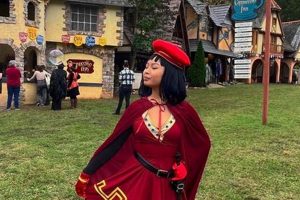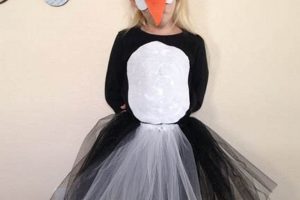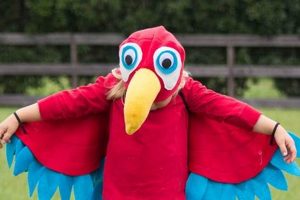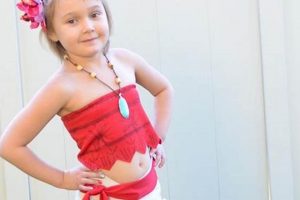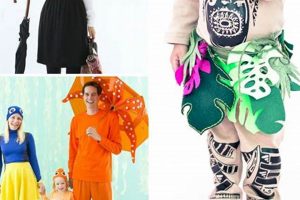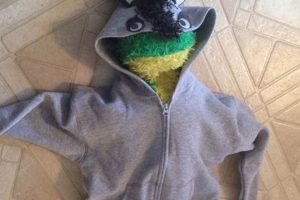Creating miniature attire for the popular Christmas figurine, often involving do-it-yourself techniques, represents a burgeoning trend. This activity encompasses the design and construction of apparel for the Elf on the Shelf character, enabling customization and personalization of its daily appearances. For example, individuals might craft a tiny superhero outfit or a miniature chef’s uniform using readily available materials.
The appeal of fabricating custom clothing for the elf stems from several factors. It fosters creativity and resourcefulness, providing a cost-effective means of enhancing the holiday experience. Furthermore, it allows families to tailor the elf’s activities to reflect specific interests or themes, thereby increasing engagement and excitement during the Christmas season. Historically, standardized elf appearances have given way to individualized presentations, driven by a desire for originality and personal expression.
The subsequent discussion will delve into accessible methods for creating miniature elf garments, highlighting material selection, basic sewing techniques, and alternative no-sew approaches. Additionally, it will explore a range of design inspirations and provide practical advice for achieving successful and visually appealing results.
Essential Guidance for Elf Attire Creation
The following recommendations offer practical advice for the successful design and fabrication of miniature attire for the Christmas figurine. Careful adherence to these guidelines will enhance the overall aesthetic and durability of the finished product.
Tip 1: Material Selection: Opt for lightweight fabrics such as felt, cotton, or thin fleece. These materials are easy to manipulate and minimize bulk on the small figure. Avoid thick or stiff fabrics, as they may be difficult to sew and can restrict the elf’s positioning.
Tip 2: Pattern Creation: Develop or utilize existing patterns scaled to the elf’s dimensions. Accurate pattern-making is crucial for ensuring a proper fit. Consider creating basic patterns for tops, bottoms, and outerwear, allowing for modular costume design.
Tip 3: Seam Allowance Management: Employ a very narrow seam allowance, typically 1/8 inch, to prevent bulky seams. Trim excess fabric closely to the stitching to further reduce bulk. Consider using a zig-zag stitch for added seam durability.
Tip 4: Closure Mechanisms: Utilize small hook-and-loop fasteners (Velcro), snaps, or miniature buttons for closures. Avoid using pins or glue as permanent closures, as these can damage the figure or present a safety hazard.
Tip 5: Embellishment Techniques: Apply embellishments sparingly to avoid overwhelming the costume. Consider using fabric markers, paint, or small beads to add detail. Ensure that all embellishments are securely attached to prevent detachment.
Tip 6: Safety Considerations: Exercise caution when using sharp tools such as scissors or needles. Supervise children closely during the creation process to prevent accidents. Ensure that all materials are non-toxic and safe for handling.
Tip 7: No-Sew Alternatives: Explore no-sew options such as fabric glue, fusible interfacing, or pre-made felt shapes. These alternatives can simplify the construction process and eliminate the need for sewing skills.
Following these guidelines will result in well-crafted and visually appealing attire for the figurine, contributing to an enhanced holiday experience. The combination of careful planning, appropriate material selection, and meticulous execution is key to success.
The concluding section will provide illustrative examples of finished creations, offering further inspiration and practical insights.
1. Miniature Scale
The characteristic small size of the Elf on the Shelf figure necessitates careful consideration of scale during costume design and fabrication. The constraints imposed by this diminutive form factor significantly influence material selection, pattern creation, and construction techniques.
- Pattern Precision
Accurate pattern drafting is paramount. A slight miscalculation can result in ill-fitting garments. Traditional pattern-making methods must be adapted to accommodate the figure’s proportions, often requiring digital tools or meticulous manual adjustments. Standard sewing patterns cannot be readily scaled down without introducing distortion or inaccuracies. For example, a 1/4-inch deviation in a pattern piece can be critically significant, leading to a garment that is either too tight or too loose.
- Material Thickness
Fabric selection must prioritize thinness and pliability. Thick fabrics create excessive bulk, impeding movement and distorting the elf’s silhouette. Lightweight materials such as felt, cotton voile, or thin fleece are often preferred. The choice of thread is equally important; fine thread is essential to avoid creating bulky seams that detract from the costume’s appearance. As an example, using denim or upholstery fabric would be impractical due to their inherent thickness and rigidity.
- Detailing Constraints
The miniature scale limits the level of detail that can be effectively incorporated into a costume. Intricate embellishments, such as tiny buttons or elaborate embroidery, may be impractical or visually overwhelming. Simplification of design elements is often necessary. Instead of functional closures, decorative elements can be employed to mimic the appearance of buttons or buckles. For instance, painted details can substitute for sewn-on embellishments to achieve a similar aesthetic without adding bulk or complexity.
- Tool Selection
Specialized tools are often required for working at a miniature scale. Small scissors, fine-tipped tweezers, and specialized needles are essential for precise cutting, manipulation, and sewing. Standard-sized sewing machines may be difficult to use for intricate stitching, necessitating the use of hand-sewing techniques. Miniature iron presses or heat-setting tools can be used to create crisp edges and secure fabric folds without damaging the delicate materials.
These considerations collectively demonstrate that the miniature scale is not merely a dimensional characteristic, but a defining constraint that fundamentally shapes the entire costume design and creation process. The successful execution of these do-it-yourself projects hinges on a thorough understanding of these limitations and the adoption of appropriate techniques and materials to overcome them.
2. Material Choice
Material choice is a foundational element of crafting apparel for the Elf on the Shelf figurine. The selection of appropriate materials directly impacts the final product’s aesthetic, durability, and ease of constr
uction. For instance, using a stiff, non-flexible fabric like canvas will result in a bulky, ill-fitting garment, while a soft, pliable material like felt allows for greater maneuverability and a more realistic drape. The causal relationship is clear: incorrect material selection leads to construction difficulties and a compromised final appearance. The importance of judicious material choice in these do-it-yourself projects cannot be overstated; it is as crucial as accurate pattern drafting or precise sewing techniques.
Practical applications of understanding this connection are evident in several common crafting scenarios. For example, opting for lightweight cotton allows for intricate detailing, such as small ruffles or pleats, without adding excessive bulk. Using felt, a non-fraying material, eliminates the need for hemming, simplifying the construction process for novice crafters. Furthermore, the durability of the chosen material directly affects the longevity of the costume. A fabric that tears easily will require frequent repairs, diminishing the overall value of the project. Choosing materials with washability considerations also ensures the costume can be cleaned if soiled during its use.
In summary, selecting the right materials for elf attire creation is crucial for achieving successful and visually appealing results. Challenges may arise from limited material availability or budgetary constraints, but a comprehensive understanding of fabric properties and their impact on the final product can mitigate these issues. The connection between material choice and the overall success of these do-it-yourself endeavors is undeniable, highlighting the need for careful planning and informed decision-making at the outset of any project.
3. Pattern Simplicity
Pattern simplicity constitutes a critical element in the success of any “elf on the shelf costume diy” project. The diminutive scale of the figure and the often limited sewing expertise of the creators necessitate designs that are straightforward to execute. Intricate patterns with numerous small pieces and complex construction techniques significantly increase the likelihood of errors and frustration, potentially leading to abandoned projects. Conversely, simplified patterns, characterized by fewer pattern pieces and basic sewing steps, enhance accessibility and the probability of a satisfactory outcome. For instance, a simple tunic pattern, consisting of a front, back, and two sleeves, is far more manageable than a complex tailored jacket pattern for the same figure.
The benefits of pattern simplicity extend beyond ease of construction. Simplified patterns typically require less fabric, reducing material costs and minimizing waste. They also lend themselves to easier modification and customization. Creators can readily adapt basic patterns to create a variety of different costumes by altering fabric choices, adding embellishments, or making minor adjustments to the pattern shape. Furthermore, simpler patterns often require fewer specialized tools or equipment, making them accessible to a wider range of individuals. For example, a no-sew costume constructed from felt shapes relies entirely on pattern simplicity and eliminates the need for sewing machines or advanced sewing skills.
In conclusion, pattern simplicity is not merely a desirable characteristic of “elf on the shelf costume diy” projects, but a fundamental requirement for ensuring accessibility, affordability, and successful completion. While complex and elaborate designs may be aesthetically appealing, their practical execution often presents insurmountable challenges. By prioritizing simplified patterns, creators can maximize their chances of producing satisfying and enjoyable costumes, thereby enhancing the overall holiday experience. The potential for future investigation includes exploring methods for further simplifying existing patterns and developing resources for novice crafters to learn basic pattern-making skills.
4. Attachment Method
The attachment method constitutes a critical component of successful “elf on the shelf costume diy” projects. The chosen method directly impacts the functionality, aesthetic appeal, and safety of the finished costume. Ineffective attachment can lead to wardrobe malfunctions, compromising the intended effect and potentially posing hazards to the figurine. Conversely, a well-considered attachment strategy ensures secure garment placement, ease of use, and prolonged costume integrity. For example, employing adhesive substances that degrade the figurine’s surface material can result in permanent damage, whereas utilizing strategically placed hook-and-loop fasteners offers a reversible and non-destructive alternative.
Practical application of this understanding is evident in various costume design considerations. Utilizing miniature snaps or buttons, while aesthetically pleasing, may prove difficult to manipulate due to their size. Alternatives such as elastic closures or strategically placed seams can provide secure and functional attachment without requiring fine motor skills. Furthermore, the choice of attachment method must account for the costume’s intended purpose and frequency of use. Costumes designed for daily repositioning of the elf benefit from easily adjustable and reusable attachment mechanisms, while those intended for a single display may accommodate more permanent solutions, such as minimal adhesive or tacking stitches. These approaches ensure secure, safe, and visually acceptable results.
In summary, the attachment method is inextricably linked to the success of “elf on the shelf costume diy”. A thorough understanding of available options and their respective advantages and disadvantages enables informed decision-making, leading to durable, functional, and aesthetically pleasing costumes. Challenges such as sourcing appropriate materials or mastering intricate attachment techniques can be overcome through research, experimentation, and a focus on simplicity. Ultimately, the chosen attachment strategy plays a vital role in enhancing the overall enjoyment and creative expression associated with this popular holiday activity.
5. Design Theme
The design theme exerts a considerable influence on the outcome of any undertaking. Within the context of creating miniature clothing, the design theme serves as a foundational element that dictates material selection, construction techniques, and overall aesthetic. The selection of a design theme, be it holiday-specific, character-based, or profession-oriented, shapes the creative direction of the project. For instance, a Christmas-themed costume may necessitate the utilization of red and green fabrics, embellishments such as miniature jingle bells, and patterns reminiscent of traditional holiday attire. In contrast, a superhero-themed design would call for vibrant colors, stylized logos, and patterns reflecting iconic superhero costumes. This direct correlation demonstrates the design theme’s role as a catalyst for creative decisions.
Practical applications of the design theme principle are evident in the crafting process. A well-defined design theme provides a cohesive framework, ensuring that all elements of the costume align harmoniously. Without a clear theme, the resulting creation
may appear disjointed and lacking in visual appeal. The design theme also informs decisions regarding the level of detail and complexity. A whimsical or cartoonish theme may permit greater artistic license and simplification of design elements, while a more realistic or sophisticated theme may necessitate meticulous attention to detail and accuracy. Real-world examples can illustrate this further: a miniature chef’s uniform demands accurate renditions of aprons, hats, and possibly even miniature cooking utensils, while a simple festive outfit may only require a patterned fabric and some basic embellishments.
In summary, the design theme is not merely a superficial stylistic choice, but an integral component of these do-it-yourself creations. It guides the entire crafting process, from material selection to final embellishments, ensuring a cohesive and visually appealing result. Challenges in this area may arise from a lack of thematic clarity or difficulty in translating complex designs into miniature form. However, a well-defined design theme serves as a roadmap for success, facilitating a creative and enjoyable crafting experience. The capacity to articulate and execute a cohesive design theme remains paramount for those engaging in the craft of fashioning small-scale apparel.
6. Durability Focus
The integration of a “Durability Focus” within “elf on the shelf costume diy” projects significantly influences the longevity and overall value of the crafted items. The inherent nature of these miniature costumes necessitates a design and construction approach that prioritizes resistance to wear and tear. The repeated handling associated with posing and repositioning the Elf on the Shelf figure subjects the costumes to considerable stress. Therefore, material selection, seam reinforcement, and attachment methods must be carefully considered to ensure the costumes withstand frequent use. For example, employing thin, loosely woven fabrics will likely result in premature fraying and tearing, whereas utilizing tightly woven, durable materials such as felt or reinforced cotton enhances the costume’s ability to endure handling.
Practical applications of this “Durability Focus” are evident in several key areas of costume creation. Reinforced seams, achieved through double stitching or the application of seam sealant, prevent unraveling and enhance the costume’s structural integrity. Secure attachment methods, such as robust hook-and-loop fasteners or firmly sewn-on embellishments, minimize the risk of components detaching during handling. Furthermore, choosing washable materials allows for the removal of stains and dirt, prolonging the costume’s lifespan and maintaining its aesthetic appeal. Consider a scenario where a child frequently handles the elf, and a poorly constructed costume quickly deteriorates, diminishing the holiday experience. Conversely, a durable costume, capable of withstanding repeated handling, provides lasting enjoyment and contributes to a more positive and engaging experience.
In conclusion, “Durability Focus” is not merely an ancillary consideration within “elf on the shelf costume diy” but a fundamental principle that directly impacts the longevity, functionality, and overall value of the crafted costumes. Overlooking this aspect can lead to premature wear, reduced enjoyment, and ultimately, a diminished return on the time and effort invested. While challenges may arise in sourcing durable materials or mastering advanced sewing techniques, the benefits of prioritizing durability far outweigh the associated difficulties. This understanding contributes to a more sustainable and rewarding approach to this popular holiday tradition.
Frequently Asked Questions
The following addresses common inquiries and misconceptions regarding the design and construction of miniature attire for the Elf on the Shelf figurine. These questions are designed to provide clear and concise information to assist in the successful execution of do-it-yourself projects.
Question 1: Is prior sewing experience required to create attire for the figurine?
No. While prior sewing experience is beneficial, it is not strictly required. Many designs can be executed using no-sew techniques, relying on fabric glue, fusible interfacing, or pre-made felt shapes. The complexity of the chosen design should align with the creator’s skill level. Simpler designs are readily achievable by individuals with limited or no sewing experience.
Question 2: What are the most appropriate materials for constructing these miniature costumes?
Lightweight fabrics such as felt, cotton, and thin fleece are generally recommended. These materials are easy to manipulate and minimize bulk. Avoid thick or stiff fabrics, as they can be difficult to work with and may not drape well on the small figure.
Question 3: How can pattern accuracy be ensured for such small-scale designs?
Precise pattern drafting is essential. Utilize digital tools or meticulously measure and scale existing patterns to the elf’s dimensions. Consider creating basic patterns for tops, bottoms, and outerwear, allowing for modular costume design. A slight miscalculation can significantly impact the final fit of the garment.
Question 4: What are the safest and most effective methods for attaching costumes to the figurine?
Small hook-and-loop fasteners (Velcro), snaps, or miniature buttons are recommended for closures. Avoid using pins or glue as permanent closures, as these can damage the figure or present a safety hazard. Ensure that all closures are securely attached to prevent detachment during handling.
Question 5: How can durability be maximized in these miniature creations?
Employ durable materials, reinforced seams, and secure attachment methods. Double stitching or the application of seam sealant can prevent unraveling and enhance structural integrity. Washable materials allow for the removal of stains and dirt, prolonging the costume’s lifespan.
Question 6: What design themes are most commonly employed in these projects?
Design themes vary widely, ranging from holiday-specific motifs (Christmas, Halloween) to character-based designs (superheroes, fairytale characters) and profession-oriented themes (chef, doctor). The chosen theme should align with the creator’s interests and skill level. A well-defined theme provides a cohesive framework for the entire project.
In summary, successful miniature attire creation hinges on careful planning, appropriate material selection, and meticulous execution. Addressing these frequently asked questions provides a solid foundation for undertaking these do-it-yourself projects.
The subsequent discussion will delve into illustrative examples of finished creations, offering further inspiration and practical insights.
Conclusion
This exploration of “elf on the shelf costume diy” has illuminated the critical aspects involved in creating miniature apparel for the popular holiday figure. It has underscored the importance of material selection, pattern simplicity, secure attachment methods, thematic cohesion, and a focus on durability. Each element contributes significantly to the success and longevity of these do-it-yourself projects.
The practice of crafting attire for the Elf on the Shelf represents a confluence of creativity, resourcefulness, and personalized holiday expression. Individuals and families seeking to enhance their festive traditions are encouraged to apply these principles, fostering both imaginative engagement and enduring enjoyment. The meticulous attention to de
tail and thoughtful design detailed in this article will help ensure the lasting integrity and visual appeal of these miniature creations, contributing to a richer and more engaging seasonal experience.


